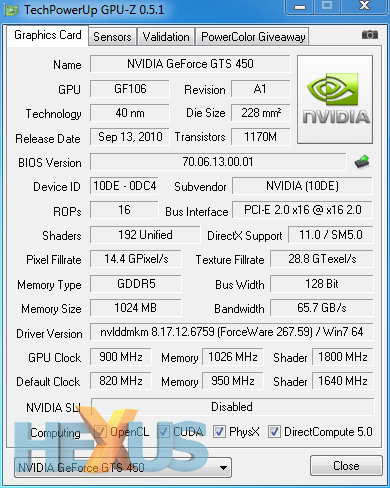On an equal footing
NVIDIA's GeForce GTX 550 Ti graphics card, released this Tuesday, is something of an oddity. What makes it a tad strange isn't the underlying architecture, which is better than the last-generation GTS 450, but the price. Available from the usual band of partners in pre-overclocked form, the GTX 550 Ti currently retails between £112-£150, depending upon where you shop and which retailer you purchase from.
Now, the problem for the new GPU comes primarily from NVIDIA's own stable. A last-generation GeForce GTX 460 1GB card can be purchased from £130, and it is a significantly faster GPU from a performance perspective. Yes, the power credentials of the GTX 550 Ti are better, and a decent partner card, such as the Gigabyte 550 Ti OC, is practically silent, but why would you pay the same kind of money for an obviously performance-inferior product? GTX 550 Ti really needs to chime in at £99, including VAT, with partner OC cards available for a tenner more, we think.
Looking the other way, towards the GTS 450 1GB, and the 550 Ti is better. Technically speaking, while it has the same number of shaders, 550 Ti is clocked in at higher speeds and makes use of a third group of ROPs and memory-controllers. Please head on over the original review if you would like to know more about what makes it tick.
NVIDIA claims that the GTS 450 1GB card has been a huge success, mainly because it targets that sub-£100 sweetspot. So, taking NVIDIA's claims with a large pinch of salt, we imagine that quite a few of our readers bought one for their mid-range systems. The same readers may be wondering, given the superficial similarities between the GTS 450 and GTX 550 Ti, whether an upgrade is in order. Interested more in the technology than actual card, we're more prosaic. We'd rather learn just how the two mid-range GPUs compare when set on an equal footing.
Appreciating that the GTS 450 1GB GPU is available from £85 in bone-stock form and is ripe for overclocking past its 783MHz core and 3,600MHz memory speeds, to the extent that NVIDIA's partners have released models that can match, or better, the GTX 550 Ti's 900MHz/4,104MHz clocking, just how would a same-clocked GTS 450 compare against the 550 Ti? Stroking our virtual beards and dusting down the elbow-patch cardigans, we strove to find out.
We'd intimate that practically all GTS 450 cards can attain GTX 550 Ti speeds, though, of course, this is by no means fact. Making sure that we could clock one up to the requisite speeds without fuss, an Inno3D GTS 450 1GB iChiLL Freezer card was thrown in the test rig and pushed up.

Bear in mind that it's only the frequencies that are identical; GTS 450 has a significant memory-bandwidth and antialiasing/anisotropic filtering processing shortfall when compared to the 5-series card. With that in mind, based on the system setup on this page, let's crack on with some benchmarks.









